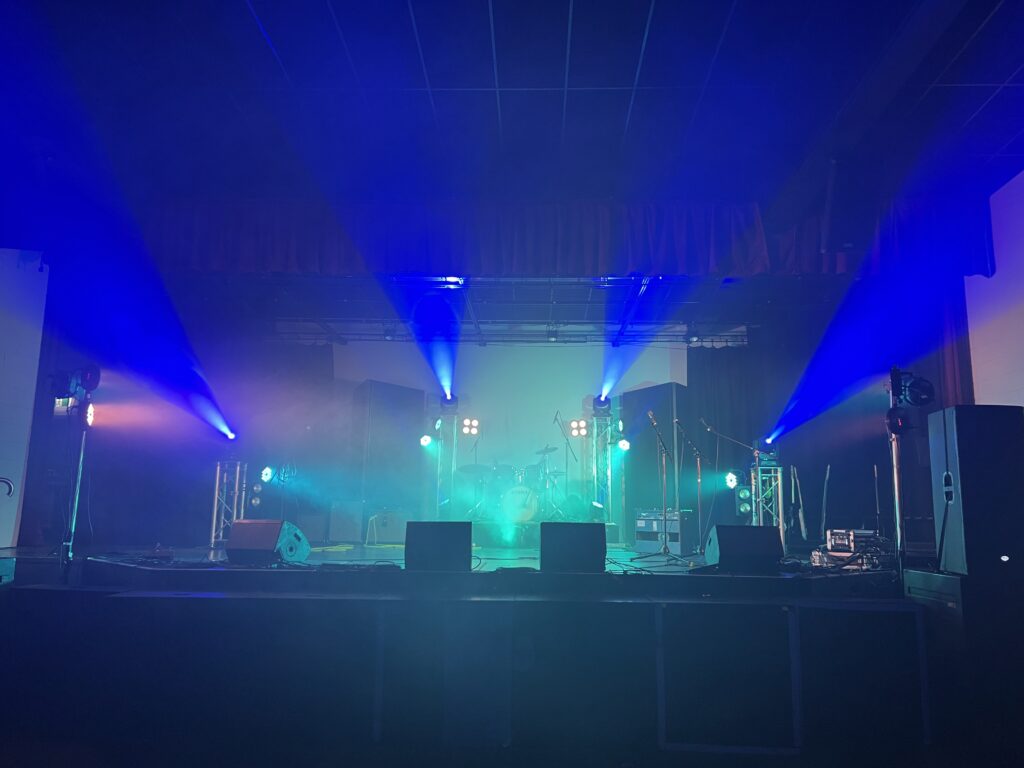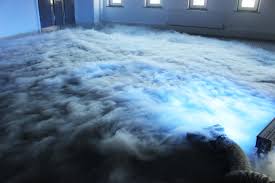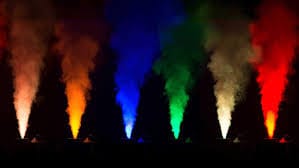What is the difference between a smoke machine, a fog machine and a hazer and their fluids?
Are you planning an event that needs a special effect to make the lighting pop? Do you want to create an eerie, low-lying fog for a spooky scene in a play? Understanding the difference between a smoke machine, a fog machine, and a hazer is the first step to choosing the right tool for the job. While the terms are often used interchangeably, these devices create very different atmospheric effects, and using the right one can make or break your event’s visual impact.
The primary distinction between these machines lies in the size and density of the particles they produce, which in turn determines how the effect behaves in the air.
- Smoke Machine (or Fog Machine): These machines create a thick, dense, and opaque cloud. They work by heating a glycol or glycerin-based fluid to a high temperature, vaporising it, and then forcing it out of a nozzle. The vapor condenses upon hitting the cooler air, creating a dramatic, white plume. This effect is great for a quick, impactful burst of atmosphere, but it can obscure visibility and dissipates relatively quickly.
- Hazer: A hazer is designed to produce a fine, translucent mist that is much less visible to the naked eye. It works by either heating a fluid at a lower temperature or, in professional oil-based models, atomising the fluid using a compressor. The tiny particles in the haze hang in the air for a long time, making them perfect for catching light beams and lasers without blocking the audience’s view of the stage. This is the effect you see at most large concerts and festivals.

Fluids and Their Properties
The type of fluid used is a major factor in the machine’s output and behaviour. Most fluids are a mixture of deionised water and a glycol compound (like propylene glycol or glycerin). The density of the fluid is often a key indicator of its performance.
- Standard Fluid: Typically produces a mid-density fog that is a great all-rounder for general use.
- Heavy Fog Fluid: Designed to create a thicker, more persistent fog. This fluid has a slower dissipation rate and is ideal for “fog-out” effects.
Water-Based vs. Oil-Based Hazer Fluids
There are two main types of fluid used in hazers, each with distinct benefits and disadvantages.
- Water-Based Fluids: These are made from a water and glycol mixture. They are a common choice because they are generally considered safer for breathing in high concentrations and do not leave an oily residue on surfaces or equipment. The haze they produce is lighter and disperses more quickly than oil-based haze.
- Oil-Based Fluids: These are made from a mineral oil base and are typically used in professional-grade hazers with a compressor. They produce an extremely fine, long-lasting mist that hangs in the air for hours with minimal change. The disadvantage is that they can sometimes leave a residue on surfaces over time and can be more likely to trigger certain types of fire alarms that detect hydrocarbons.
How to Create Low-Lying Fog Special FX
A professional “low-lying fog” effect, often called “dancing on a cloud,” requires the fog to be colder than the ambient air so it stays close to the ground. A conventional fog machine produces warm fog that rises. To achieve the graveyard or Halloween effect, you must cool the fog down before it enters the room.
The most common and effective DIY method for this is a “fog chiller”:
- Get a Container: You’ll need a plastic bin or cooler with a lid.
- Add Ice: Fill the container with a large amount of ice or, for a more sustainable option, several frozen water bottles or even some packets of frozen vegetables!
- Create a Path: The fog from the machine needs to be channelled into the container, pass over the ice, and then exit at a low point. You can create an entry and exit port using PVC pipes or other suitable materials.
- Connect and Chill: Connect the nozzle of your smoke machine to the entry port. As the fog is pumped into the container, it passes through the cold environment created by the ice. This dramatically cools the fog, causing it to hug the floor when it exits the container.
This effect will last until the fog warms up to room temperature, at which point it will begin to rise and dissipate.
For a great visual guide on how to create this effect at home, check out this popular video:
- Easiest DIY Fog Chiller, for Less than 15 Bucks!! – This video provides a clear, step-by-step guide to building a simple fog chiller with household items.

More Special FX: Creating a CO2 Cannon Effect with a Smoke Machine
You can create a dramatic burst of vertical smoke that mimics a CO2 cannon by using a fast-dissipating smoke fluid and a professional vertical fog machine. These machines are designed to shoot a powerful plume of smoke straight up into the air, often with LED lights to colour the effect. The key to this effect is the fluid’s density—a fast-dissipating formula will create a quick, clean burst that disappears in a matter of seconds, just like a real CO2 cannon.

Contact Us
Need to hire a smoke machine or hazer for your next event? Contact The Rock Factory for our professional lighting hire solutions in Auckland.
- Call Us: +64 21 358 577
- Email Us: admin@therockfactory.net
© 2025 The Rock Factory Limited. All rights reserved. Your trusted event atmosphere creative technology partner.
